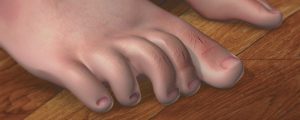 Hammertoes are most frequently caused by structural problems in the toe or from wearing poor fitting shoes. It causes the middle joint to bend. Hammertoe is most frequently caused by structural problems in the toe or from wearing poor fitting shoes. It is important to diagnose and treat hammertoe early because the condition tends to become worse over time. If left untreated, hammertoe can require surgery.
Hammertoes are most frequently caused by structural problems in the toe or from wearing poor fitting shoes. It causes the middle joint to bend. Hammertoe is most frequently caused by structural problems in the toe or from wearing poor fitting shoes. It is important to diagnose and treat hammertoe early because the condition tends to become worse over time. If left untreated, hammertoe can require surgery.
Your toes are part of your forefoot. They help you balance, walk, and move. Your big toe contains two bones. Your second through fifth toes contain three bones. Hammertoe results when the middle joint is bent.
Causes
Hammertoe commonly develops because of structural changes that take place over time in the muscles and tendons that bend the toes. People with certain medical conditions, such as diabetes, are at risk for developing hammertoe. It can be an inherited condition for some people. Other causes include trauma and wearing shoes that are too tight, narrow, or have high heels. The toe next to the big toe is most frequently affected by hammertoe.
Symptoms
The symptoms of hammertoe are progressive, meaning that they get worse over time. Hammertoe causes the middle joint on the second, third, fourth, or fifth toes to bend. The affected toe may be painful or irritated, especially when you wear shoes. Areas of thickened skin may develop between, on top of, or at the end of your toes. Thickened skin may also appear on the bottom of your toe or the ball of your foot. It may be difficult to find a pair of shoes that is comfortable to wear.
Diagnosis
Your podiatrist can diagnose hammertoe by reviewing your medical history and examining your foot. X-rays are typically done.
Treatment
There are many non-surgical treatments to help relieve symptoms of hammertoe. The first step for many people is wearing the right size and type of shoe. Low-heeled shoes with a boxy or roomy toe area are helpful. Cushioned insoles, customized orthopedic inserts, and pads can provided relief as well. Splints or straps may be used to help correct toe position.
Your podiatrist may show you toe stretches and exercises to perform, and can safely remove corns and calluses. You should not try to remove them at home.
Surgery
Surgery is used when other types of treatment fail to relieve symptoms or for advanced cases of hammertoe. There are several types of surgery to treat hammertoe. A small piece of bone may be removed from the joint. The toe joint may be fused to straighten it. Surgical hardware, such as a pin and screws may be used to hold the bones in place while they heal. Other types of surgery involve removing skin (wedging) or correcting muscles and tendons to balance the joint.
Collier Podiatry, P.A.
Michael J. Petrocelli
D.P.M., F.A.C.A.S., C.W.S.P.
239-775-0019
www.collierpodiatry.com








